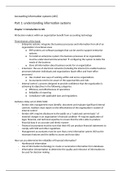Samenvatting
Summary book: Accounting Information Systems [Chapters 1-3, 5, 7-9] (11th ed.)
- Instelling
- Tilburg University (UVT)
This is a summary of the book Accounting Information Systems: Gelinas, U.J., R.B. Dull, P. Wheeler, and M.C. Hill (2018), 11th edition. This summary contains the chapters: 1-3, 5, 7-9.
[Meer zien]





